| Pilgrim Places
| |||||
Sitting alone in the 8 seater tempo with my rucksack for company, I watched the driver soliciting passengers for Rishikesh. I could see the bathing ghats at Har Ki Pauri, the hurried activity, feverish need for absolution and the ritual baths. I can only relate to Haridwar in the dead of night, when the sound of the Ganga stills my senses. We headed towards Rishikesh, minus any other passengers. Impressions of Haridwar by Romola Butalia Despite his promise to drop me off at the Garhwal Mandal Vikas Nigam outfit, at the bus stop in town the driver decided that he was too hungry to continue further. I found myself the ideal location to stay at the Swiss cottages near Lakshman Jhula: inexpensive, quiet, family run. It is a large complex with an Internet café, German bakery, restaurant et al. I elected to stay in a room facing the forest, completely separate from the rest of the complex. |
More on Uttarakhand • Overview • Uttaranchal Districts • Badrinath • Haridwar • Rishikesh • Char Dham • Mussoorie
Travelogues
Pilgrimages
Trekking | ||||
After breakfast at a roadside dhaba, I took a bus to Vashisht gufa over 20 kms away. Sitting alone in the dark cave, I was so immersed in the moment I must have spent at least an hour there, before walking down to the river below, just as I had done 3 years ago. Back at Rishikesh, over lunch at the dhaba, I decided on impulse to head towards Badrinath planning to stop over for the night at Srinagar or Rudraprayag. Impressions of Rishikesh by Romola Butalia
All night, I could hear the river below and from my window I had a spectacular view of the sangam of the Alaknanda originating from Badrinath, and the Mandakini originating from Kedarnath. Rudraprayag is situated at the confluence of the two rivers and it is believed that Lord Shiva appeared in his Rudra Avtar when Narad Muni worshipped him here in order to master the mysteries of music. I walked through the length and breadth of the town, had an early dinner and slept peacefully. The morning found me, rucksack on back, waiting for a bus to Badrinath, which took a couple of hours in coming. From Joshimath to Badrinath, the gate opens at specific times and we were lucky to catch the 2 o'clock gate. Badrinath is in the midst of cold high mountains, surrounded by ice sheets, exceedingly beautiful. I checked in at the GMVN which had only dormitories of 20 beds each, 500 beds in all, much like a train. I wasn't delighted with the accommodation and hunted around a bit but didn't find anything much better. Another GMVN outfit I checked out, had damp double rooms, toilet not attached, quite unpleasant. I did not want to waste too much time on my trip hunting for a night's stay at each of the places I halted at. As it happened, I had some interesting conversations with fellow-bunkers, a young Garhwali couple and a retired geologist and his wife. On the bank of the Alaknanda, encircled in a beautiful valley with the snowy peaks of Neelkanth, Nara and Narayana visible, the ancient historical temple of Badrinath dating back to Vedic times, was re-built by Adi Shankaracharya in the 8th Century. The temple has been renovated several times due to damage by avalanches. The complex has 15 idols, chief among which is the one metre high, finely sculpted, black stone image of Badrinath representing Lord Vishnu in a meditative pose. On the left side of the main temple is the temple of Lord Adikedareshwar. Legend has it that when Shiva lived here with Parvati, Vishnu came in the form of a small child whom Parvati in her compassion took into her home, against Lord Shiva's advice. They went out leaving the small child and returned to find that the child was none other than Narayan himself who had, as he had planned, taken over their dwelling. Shiva shifted his abode to Kedarnath where he is worshipped as one of the 12 jyotirlingas.
I walked back the way I had come, paying my respects at the Bhrigu gufa and stopping to see the fossilised 'nag-nagin' jora I had been told of - two snakes, immortalised together in stone forever. After a quick lunch in town, I proceeded towards the Charan Paduka, or footprints of Lord Vishnu, I found a huge stone, directly off the path, with a gigantic footprint seemingly embedded, unmarked and unhonoured. I figured that could not be it, and proceeded on the path, till I reached the icy glacial sheets. The late afternoons clouds were hedging inwards. Completely alone, without a stick, gingerly attempting to cross the sheer ice sheet, towards the path I could see ahead, with the river roaring one fatal slip below, I realised retreat would be a wiser move. I decided to go back a couple of kms to where I had seen a gufa with some Vaishnavite sadhus in it, and check the direction I should be going. They informed me I had gone far ahead of the paduka, which was indeed the one I had seen, and had proceeded on the trail to Neelkanth, presently inaccessible. I was invited to join them and spent the afternoon sipping warm water and discussing the recognition of manifestations of divinity in the Kali Yuga as compared to earlier Yugas. Rested, I headed back and spent the evening at the Nath Sampradaya ashram, where the mahant took considerable time off to clarify various gaps in my knowledge about the Nath Sampradaya, a sect who have remained largely obscure, and about whom, I had read whatever I could get my hands on. I spent a long evening in an involved and lively discussion on the philosophy and practices of the Naths and on various esotric doctrines credited to Guru Gorakh Nath. After joining him for his evening meal I finally wended my way back to the GMVN, intending to head off the next morning towards the Valley of Flowers. As I set off in the morning, I had already left Badrinath behind.
|
|||||
Editor: Romola Butalia (c) India Travelogue. All rights reserved. |
|||||
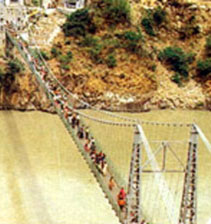 I paid a mandatory visit to Lakshman Jhula, and watched the bridge, the river and the people, from the German bakery, before I went for my evening meal, reading a book while waiting for dinner, as one often sees lone travellers do. I returned to my room to a breaking storm, flashes of lightning, rumbling thunder and lashing rain. There was something very comforting about the onslaught of rain and the closeness to Nature.
I paid a mandatory visit to Lakshman Jhula, and watched the bridge, the river and the people, from the German bakery, before I went for my evening meal, reading a book while waiting for dinner, as one often sees lone travellers do. I returned to my room to a breaking storm, flashes of lightning, rumbling thunder and lashing rain. There was something very comforting about the onslaught of rain and the closeness to Nature.
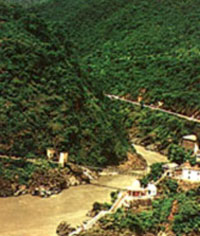 The bus to Rudraprayag took over 5 and a half hours and I reached to find the town stretched to its limits with the railway minister and his entourage passing through. There was an acute shortage of accommodation at the peak season on the pilgrimage route to Badrinath and Kedarnath. The management at the GMVN were exceptionally helpful, shifting a bed into the office, giving me a place to stay for the night and making sure I was comfortable.
The bus to Rudraprayag took over 5 and a half hours and I reached to find the town stretched to its limits with the railway minister and his entourage passing through. There was an acute shortage of accommodation at the peak season on the pilgrimage route to Badrinath and Kedarnath. The management at the GMVN were exceptionally helpful, shifting a bed into the office, giving me a place to stay for the night and making sure I was comfortable. 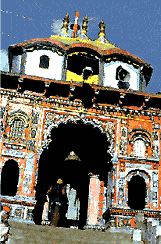 I walked to the mandir and stood in the queue amidst the devotion, the fervour, the push and shove for darshan, sooner rather than later. I hardly caught a glimpse of the inside of the temple, and elected to opt out of the queue, hurriedly walking away to be able to appreciate the beauty and the grandeur of Badrinath, instead. At the little Shiva temple in the precinct, I stopped to pay homage. It was empty and quiet, no crowds, no religious fervour, no ritualistic worship. Outside a few Naga sadhus, covered in ash, prepared their bhojan. As I walked out, one of them stopped me just long enough to place a vibhuti tilak on my forehead, in seeming acknowledgement of the outsider, as Shiva worshippers always are.
I walked to the mandir and stood in the queue amidst the devotion, the fervour, the push and shove for darshan, sooner rather than later. I hardly caught a glimpse of the inside of the temple, and elected to opt out of the queue, hurriedly walking away to be able to appreciate the beauty and the grandeur of Badrinath, instead. At the little Shiva temple in the precinct, I stopped to pay homage. It was empty and quiet, no crowds, no religious fervour, no ritualistic worship. Outside a few Naga sadhus, covered in ash, prepared their bhojan. As I walked out, one of them stopped me just long enough to place a vibhuti tilak on my forehead, in seeming acknowledgement of the outsider, as Shiva worshippers always are.
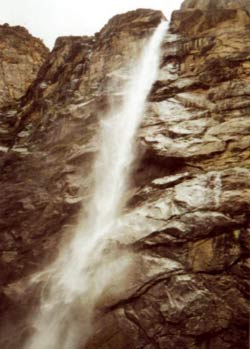 I walked silently through the town huddled in my jacket as I wandered around with icy winds chilling me. Early next morning, I took the trail past the mandir, through village fields, on to Mana, the last village before Tibet. It was a wonderful 3-4 km walk, with hardly a villager on the way. I stopped at the Ganesh Gufa (cave), and thereafter, sat in meditation at the Vyas Gufa, where it is believed that Ved Vyas wrote the epic, Mahabharat. After awhile, the pujari entered and chanted shlokas in worship that formed the backdrop to my own silent reveries and queries, undisturbed in my mindspace. When I finally opened my eyes, the pujari indicated that I could place an offering. In explanation of coming empty-handed, I replied that I had come for tapasya, which he acknowledged immediately with folded hands, an offer of prasad and a tika placed on my forehead. I went to the Bhim Pul, a natural bridge, below which flows the legendary mythological Saraswati river which merges with the Alaknanda, just ahead. A small temple dedicated to Saraswati is just beyond the bridge, the path leading onto the waterfalls at Vasundhara, 5 kms away.
I walked silently through the town huddled in my jacket as I wandered around with icy winds chilling me. Early next morning, I took the trail past the mandir, through village fields, on to Mana, the last village before Tibet. It was a wonderful 3-4 km walk, with hardly a villager on the way. I stopped at the Ganesh Gufa (cave), and thereafter, sat in meditation at the Vyas Gufa, where it is believed that Ved Vyas wrote the epic, Mahabharat. After awhile, the pujari entered and chanted shlokas in worship that formed the backdrop to my own silent reveries and queries, undisturbed in my mindspace. When I finally opened my eyes, the pujari indicated that I could place an offering. In explanation of coming empty-handed, I replied that I had come for tapasya, which he acknowledged immediately with folded hands, an offer of prasad and a tika placed on my forehead. I went to the Bhim Pul, a natural bridge, below which flows the legendary mythological Saraswati river which merges with the Alaknanda, just ahead. A small temple dedicated to Saraswati is just beyond the bridge, the path leading onto the waterfalls at Vasundhara, 5 kms away.
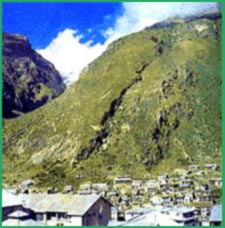 which are imprinted on a boulder in a beautiful meadow on the trail to Neelkanth. Considering how many pilgrims throng to Badrinath daily, I met none on my uphill climb. On the way, I passed a small ashram and was invited in for lunch, which I declined, having just eaten. I rested awhile there stating that I was in a hurry to get back, intending to leave Badrinath later that afternoon, if possible. The sadhu in charge immediately said, "You are not comfortable where you are staying? If money is a problem you are welcome to stay here as long as you like. You can eat your meals here as well." I thanked him for his generous offer and went on my way towards the Charan Paduka.
which are imprinted on a boulder in a beautiful meadow on the trail to Neelkanth. Considering how many pilgrims throng to Badrinath daily, I met none on my uphill climb. On the way, I passed a small ashram and was invited in for lunch, which I declined, having just eaten. I rested awhile there stating that I was in a hurry to get back, intending to leave Badrinath later that afternoon, if possible. The sadhu in charge immediately said, "You are not comfortable where you are staying? If money is a problem you are welcome to stay here as long as you like. You can eat your meals here as well." I thanked him for his generous offer and went on my way towards the Charan Paduka.